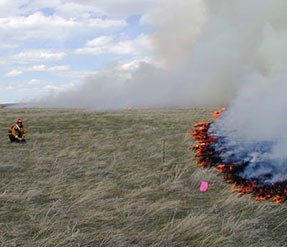
How to Keep Your Prairie HappyFor the first three years, your prairie plants are putting most of their energy into their root systems, so your prairie may look sparse or slightly ragged. Be patient though, because soon your plants will establish themselves and you will have a beautiful prairie! To maintain your prairie, mow, burn and control weeds and woody plants. Mowing helps control weeds, be sure to mow before the weeds go to seed and before they are too tall (6-8 inches). You will need to rake off the clippings so that they don't choke out the plants. It is a good idea to use a mulching mower and rake only periodically because raking may strip some of the nutrients from the soil. Pay special attention to weeds and woody species because mowing isn't as good as burning for combating these types of plants. Fertilizing and WateringDon't use fertilizers! Prairie plants don't need it, and weeds thrive with extra nitrogen. If your soil is too high in nitrogen, you may want to incorporate organic matter (such as straw) into your soil while cultivating. If you want to encourage plant growth, look into adding beneficial microorganisms to your soil. If you are forced to rake your site regularly, you may need to add some fertilizer, but use extreme caution because you may end up stimulating weeds. You don't need to water your prairie either. Seedlings are somewhat susceptible to drought, but prairie plants are very drought resistant. BurningPrairies are fire-dependent ecosystems, and burning is the best way to maintain your prairie. Burning rejuvenates and warms up the seedbed, encouraging germination. It also releases nutrients and helps to discourage weeds and woody plants. Warming the soil extends the growing season, prairie plants grow taller and produce more flowers and more seeds following a burn. Before you burn it is very important that you find out if there are ordinances you must follow. Contact your county or city clerk to find out which regulations and ordinances pertain to burning your site. Obtain the appropriate permits from your fire department. It is also important to notify your neighbors about your burning, and answer any questions or concerns they have. Prairie burns must be planned carefully. Consider all variables that could cause problems, such as combustible buildings and trees. Firebreaks are extremely important because they keep the fire from spreading beyond your site. Take into account natural firebreaks such as trails and streams, and mow a 10 to 15-foot border around the area you ant to burn. Mowing before you burn will help keep flames low, which your neighbors will probably appreciate. Fire can be dangerous, so if you don't have any experience with burning a prairie, you can volunteer to help at larger restoration sites, and many restoration companies offer burning and mowing services. A site should be burned every three to four years, depending on litter build-up. Never burn more than one 1/3 of your site in order to keep wildlife and promote diversity. Burning in early spring will remove competing plants and hurt cool season grasses. Burning later on in the summer will do the most damage to invasive weeds. Never burn when it is extremely dry because the fire can easily get out of control. Burning in the fall is good for fighting woody species, but be careful because it is often dry. It is important to control weedy species so that they don't begin to take over your prairie. Woody trees and shrubs should also be removed before they begin to establish themselves. Failure to keep weeds and woody plants in check could result in an infestation that may get out of control. Become familiar with weedy species through plant guides. The First Three YearsIt will take a few years before your site begins to look like an established prairie. During the first year, concentrate on keeping weeds at bay. You will need to mow probably 3 or 4 times during the growing season. Be sure to set your mower higher than the height of the prairie seedlings, usually 4 or 5 inches. Don't let the weeds get taller than 6-8 inches, and don't let them go to seed. In the second year of your prairie planting, annual weeds should be almost gone and the short-lived prairie perennials (gray-headed coneflower, showy tick-trefoil) should be fairly well established. Mow your site one or two times this growing season, and only if weeds are a problem. Don't mow any shorter than 8 inches. If necessary, use glyphosate, but use sparingly, being careful not to hurt your native prairie seedlings. In the third year, many assorted plants will be established and a prescribed burn is recommended to stimulate growth and combat weeds. Only burn if there is enough litter present. After you burn, you may want to interseed some areas of your prairie. If you can't possibly burn, then mow your prairie. Burn if at all possible because it is more effective at maintaining your prairie. Long-term MaintenanceKeep in mind that it might take 10 or more years for some prairie plants to bloom (such as Culver's Root), so be patient as more plants establish themselves. Burn or mow your site each year, burning or mowing approximately 1/3 of your site each time. Fertilize only if you rake after mowing on a regular basis, but do so with care because you may end up encouraging weeds. As your prairie matures, interseed or plant seedlings to promote species diversity and prairie stability. Continue to be vigilant about controlling weeds. Enjoy your prairie! Prairie Restoration
Restoration Projects |
Last updated: April 9, 2021
